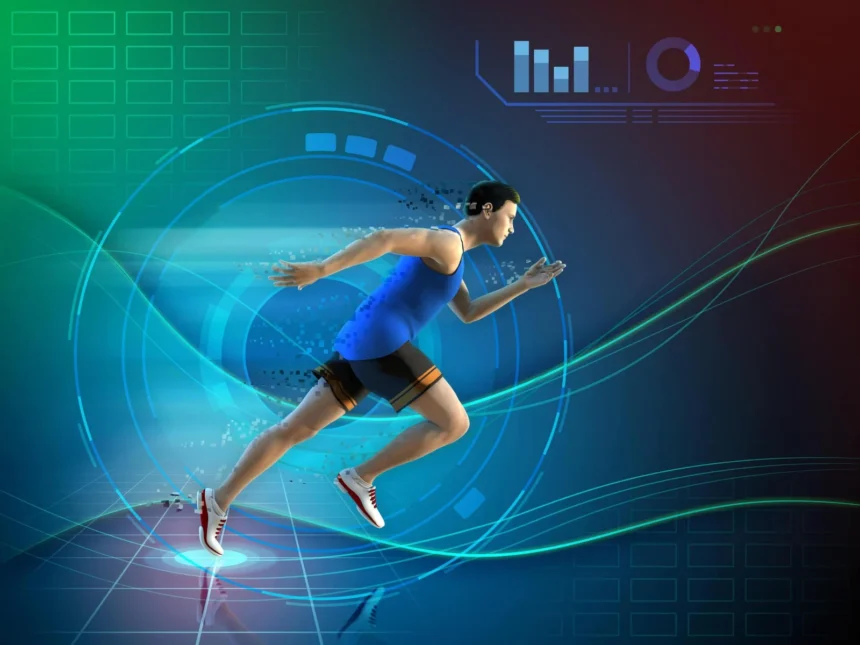The world of sports is undergoing a thrilling transformation, all thanks to the leaps and bounds made in technology. Remember when pure talent and relentless hard work were the sole beacons guiding an athlete’s journey? Those days are evolving as we speak.
Now, embrace a new era where wearables, analytics, and cutting-edge performance enhancement tools step into the spotlight, offering athletes and coaches finely-tuned data to elevate their game.
This technological revolution isn’t just about better training methods or reducing injury risk—it’s also making the games we love more exciting than ever for fans.
Our team has dedicated years to diving into how technology is reshaping sports at every level—from community fields to grand professional stadiums. We’ve witnessed with our own eyes how a snippet of data can alter the trajectory of an athlete’s career forever.
In this exploration, we’re delving into today’s most influential tech trends that are redefining athleticism: from wearables that monitor every movement to analytics that transform raw figures into strategic gold, not forgetting breakthrough innovations that redefine what athletes are capable of achieving.
Ready to take a deeper dive? Let’s get started!
Key Takeaways
- Wearable devices like fitness watches and heart rate monitors give athletes real-time feedback on their performance. This helps them improve their skills by tracking progress during training.
- Advanced technology such as GPS sensors and VBT sensors are used to prevent injuries by tracking how much athletes move and how they train. These tools help identify risky patterns that could lead to injuries.
- Helmets and mouthguards with built-in sensors protect players from head injuries by monitoring impacts during sports activities. They provide data that can prevent concussions.
- Virtual reality (VR) offers fans a new way to experience sports, making them feel like they are part of the action from anywhere in the world.
- Sports technology not only boosts athlete performance but also enhances fan engagement through immersive viewing experiences and keeps players safer with injury prevention tools.
How Sports Technology is Revolutionizing the Industry
Sports technology is transforming the industry by enhancing the viewing experience, preventing and diagnosing injuries, maintaining fair play, integrating wearables for athletes, and utilizing data tracking and collection technology.
This revolution in sports technology is shaping a new era of athlete performance enhancement.
Enhancing the viewing experience
We’ve seen firsthand how technology transforms the way fans enjoy sports. High-definition slow-motion replays let viewers catch every detail of the action that they might have missed in real time.
This feature has changed how we watch games, making those nail-biting moments even more thrilling. Along with multiple camera angles, fans can feel like they’re right in the middle of the action, whether they’re sitting at home or on the go.
It’s all about bringing every play into sharp focus and ensuring no one misses a beat.
Virtual reality (VR) takes this immersion to another level, placing fans virtually on the field or court. Imagine standing next to your favorite player as they score the winning goal or hit a home run; that’s what VR technology is starting to offer.
We’ve experimented with these technologies ourselves and can vouch for their game-changing potential in enhancing spectator experiences. The excitement builds not just from watching but feeling part of every moment through advanced tech innovations.
Next up: exploring how these technologies are reshaping injury prevention measures in sports.
Preventing and diagnosing injuries
Wearable technology aids in injury prevention and diagnosis through real-time tracking and analysis. Mouthguards and helmets are equipped with diagnostic programs to assess impact forces and detect potential injuries.
Wearable fitness watches monitor heart rate, alerting athletes to potential issues during training or competition. These advancements support proactive injury management, enabling athletes to train and perform at the highest level while minimizing the risk of injury.
Sensors embedded in sports equipment help diagnose injuries by capturing biomechanical data during play. This information is crucial for identifying problematic movement patterns that may lead to chronic injuries if not addressed timely.
Sleep tracking devices provide insights into recovery needs, supporting tailored training programs to prevent overuse injuries. The integration of wearable technology in injury prevention strategies reflects a commitment to athlete well-being, ultimately enhancing performance on the field.
Keeping games fair
As we transition to the topic of keeping games fair, it’s important to highlight how technology plays a pivotal role in ensuring fairness in sports. From advanced video assistant referee (VAR) systems to goal-line technology (GLT), sports technology stands as a robust pillar upholding the integrity of games.
By leveraging VAR and GLT, referees can make accurate decisions, minimizing human error and ultimately preserving the fairness of sporting events. In addition, Hawk-eye sensors are instrumental in tracking ball trajectories with precision, providing vital information for making fair calls on contentious plays.
Wearable fitness technology is not merely limited to enhancing individual athlete performance; it also contributes significantly to maintaining fairness in sports. Through data analytics and performance tracking, wearable devices offer insightful metrics that aid in monitoring athletes’ adherence to rules and regulations during competitions.
Incorporating wearables for athletes
Wearable technology is reshaping the way athletes train and perform. Fitness watches, heart rate monitors, and sports helmets are just a few examples of how wearables are providing real-time data insights for athletes.
These devices track an athlete’s progress during workouts or competitions, offering valuable information on their performance and physical condition. Wearable technology allows coaches and sports scientists to monitor vital statistics such as heart rate, distance covered, speed, and even impact force while also enabling personalized training programs based on individual biometrics.
Sports technology companies specializing in wearable tech for athletes have developed advanced devices that harness data analytics to enhance athletic performance. The seamless integration of wearables into an athlete’s routine provides actionable insights that can guide training regimens and optimize overall health and fitness levels.
Utilizing data tracking and collection technology
Incorporating wearables for athletes has led to a new era in sports technology. Wearable devices like fitness watches, heart rate monitors, and sports helmets are designed to collect real-time data during athletic performance.
These tools are tailored to enhance personal training programs and improve overall athletic performance through meticulous data tracking and collection. The integration of GPS sensors, VBT sensors, and sleep-tracking devices further underpins the importance of data-driven analysis in sports.
Advancing from wearable technology, the role of data tracking and collection technology in the realm of athletics is undeniable. Sports companies specializing in analytics and biomechanics use these technologies to develop personalized training programs for athletes at all levels – be it professional or amateur.
Advancing injury prevention
Transitioning from data tracking and collection technology to advancing injury prevention, we witness a concerted effort in utilizing technology to minimize the risk of injuries for athletes.
Wearable technology is enabling real-time monitoring of an athlete’s health and performance, leading to timely intervention. Mouthguards and helmets equipped with cutting-edge diagnostic programs are designed to provide advanced protection on the field, ensuring that athletes can compete safely at their peak.
The advancements in injury prevention through technology not only prioritize safety but also aim to enhance athletic longevity for sustained performance.
ALSO READ: Calculate your health risks by learning how to calculate BMI(Opens in a new browser tab)
The Impact of Wearable Sports Technology on Athletes
Wearable sports technology has transformed how athletes train and compete. It provides real-time feedback on performance to optimize training and maximize potential.
Fitness watches
Fitness watches are a game-changer for athletes, providing real-time data on heart rate, distance covered, and calories burned during training sessions. These wearables help to monitor overall fitness levels and can be worn conveniently on the wrist for continuous tracking.
Athletes can track their progress over time and make adjustments to their training regimen based on the data provided by these high-tech devices.
These wearable devices have become an essential tool for today’s athletes, offering in-depth insights into performance metrics that were previously inaccessible. Fitness watches provide valuable information about heart rates during workouts, helping athletes gauge intensity and tailor their training accordingly.
Additionally, these tools allow coaches and sports scientists to analyze an athlete’s performance more effectively.
The impact of fitness watches extends beyond just monitoring physical activities; they have also been influential in optimizing workouts through personalized tracking. This technology is setting new benchmarks in athletic training, allowing both professional and amateur athletes to elevate their performance levels significantly.
Heart rate monitors
Transitioning from fitness watches to heart rate monitors, we see a seamless integration of wearable technology in sports. Heart rate monitors provide real-time data on an athlete’s cardiovascular performance, helping to optimize training intensity and recovery.
These devices track the heart’s beats per minute, allowing for precise monitoring during workouts and competitions. The information obtained can be used by athletes, coaches, and sports scientists to tailor training programs according to individual physiological responses and enhance overall athletic performance.
Utilizing heart rate monitors is essential for gaining insights into an athlete’s physical exertion levels during training sessions or games. By understanding their heart rate patterns and adjusting their efforts accordingly, athletes can maximize their performance while minimizing the risk of overexertion or injury.
Coaches can use this data to make informed decisions about training loads and recovery strategies, ultimately contributing to improved athletic development and endurance. Furthermore, the incorporation of real-time heart rate monitoring aligns with ongoing trends in sports technology that emphasize personalized training programs tailored toward optimizing individual performance.
Sports helmets
Sports helmets are a critical part of an athlete’s gear. They provide essential protection while also incorporating advanced technology for injury prevention and performance enhancement.
For instance, modern sports helmets are equipped with impact sensors and communication systems, allowing real-time monitoring of an athlete’s condition on the field. These helmets also utilize data-tracking technology to analyze head impacts and provide valuable insights for injury prevention.
By leveraging wearable fitness technology, these helmets offer personalized training data tailored towards maximizing athletic performance.
Furthermore, sports helmets play a pivotal role in advancing safety standards for athletes. The integration of analytics and data collection within sports helmets has significantly contributed to reducing the risk of head injuries by providing meticulous tracking and analysis capabilities during games or practices.
The Role of Data Tracking and Collection Technology in Sports
Data tracking and collection technology in sports allows for precise monitoring of athletes’ performance, aiding in better training techniques. Learn more about the impact of this innovative technology on athletic development by reading our blog!
GPS sensors
GPS sensors are revolutionizing the way athletes track their performance. These sensors provide real-time data on speed, distance, and acceleration, enabling coaches and athletes to make informed decisions for training and strategy.
The use of GPS sensors has enabled a more detailed understanding of an athlete’s movements during practice or game situations. For example, in football, GPS sensors have been used to monitor player load during training sessions and matches.
Furthermore, GPS sensors are utilized not only in tracking athletic performance but also in preventing injuries by providing insights into movement patterns that could lead to overuse injuries.
VBT sensors
VBT sensors, also known as Velocity-Based Training sensors, are crucial tools for athletes and coaches. These sensors measure the speed at which an athlete performs a movement, offering real-time data on their power and strength.
VBT sensors enable personalized training programs by providing instant feedback on an athlete’s performance, allowing them to adjust their training intensity and volume based on objective data.
With VBT sensors, athletes can optimize their workouts for better results while minimizing the risk of injury.
These innovative devices have revolutionized athletic training by providing precise measurements to monitor an athlete’s progress over time. Coaches can tailor training regimens using VBT sensor data to help athletes reach peak performance levels effectively and efficiently.
Sleep tracking devices
Sleep tracking devices provide real-time data on an athlete’s sleep patterns and quality. These wearable devices can be worn comfortably while sleeping, providing insights into the duration and depth of rest.
The information collected by these devices is crucial in understanding the impact of sleep on athletic performance. By analyzing this data, athletes, coaches, and sports scientists can make informed decisions about training schedules and recovery strategies to optimize performance.
Athletes can benefit from sleep-tracking technology through improved recovery times and enhanced overall well-being. The ability to monitor sleep patterns empowers athletes to make adjustments that are tailored to their individual needs, leading to peak physical and mental readiness for their sporting endeavors.
ALSO READ: The Rise of Esports: Exploring the Competitive Gaming Phenomenon(Opens in a new browser tab)
Advancements in Injury Prevention Through Technology
Sports technology has made significant strides in injury prevention, introducing innovative methods such as smart helmets and advanced mouthguards. These technologies are designed to enhance athlete safety and well-being, promoting a more robust approach to preventing sports-related injuries.
Mouthguards
Wearable technology has transformed the realm of sports, and mouthguards are no exception. These high-tech mouthguards are designed to enhance performance and protect athletes from potential injuries.
The integration of sensors in these mouthguards allows for the collection of real-time data on impacts and head movements during athletic events, providing valuable insights into potential concussions and other head-related injuries.
This innovative technology not only enhances athlete safety but also provides coaches and sports scientists with crucial data for injury prevention strategies, making it an essential component in modern sports technology.
As technology continues to evolve, mouthguards have become a pivotal aspect of athlete safety and performance enhancement. The utilization of smart sensors within these protective gears enables real-time data collection on impact forces, contributing significantly to injury prevention efforts.
This advancement is revolutionizing the way athletes train and compete, offering invaluable information that can be utilized in shaping training regimens while maintaining optimum safety standards.
Helmets
Moving from mouthguards to helmets, it’s crucial to acknowledge the pivotal role that helmets play in injury prevention for athletes across various sports. Helmets are designed to protect the head and brain from impact, reducing the risk of serious injuries during high-impact activities.
This piece of essential gear is tailored to enhance safety by absorbing and dissipating the force of impact, providing an added layer of protection for athletes engaged in physically demanding sports such as football, hockey, cycling, and snowboarding.
With advancements in technology, helmets have evolved to incorporate features like impact sensors and communication systems, further underpinning their importance in safeguarding athletes against potential head injuries.
In today’s ever-evolving world of sports technology innovations, helmets stand out as more than just protective gear; they embody a blend of precision engineering and advanced materials designed to offer unparalleled safety without compromising comfort or performance.
Diagnostic programs
Sports technology has paved the way for diagnostic programs that can revolutionize injury prevention and athlete health. These programs use cutting-edge technology to detect early signs of potential injuries, allowing athletes to take preventive measures and stay at the top of their game.
By utilizing advanced algorithms and real-time data analysis, these diagnostic programs provide coaches and sports scientists with valuable insights into an athlete’s physical condition, ensuring a proactive approach to maintaining optimal performance.
These state-of-the-art diagnostic programs leverage wearable technology to continuously monitor athletes’ vital signs, movement patterns, and overall well-being. This allows for early intervention in case of any irregularities or potential risk factors without disrupting training or competition schedules.
The Future of Sports Technology
The future of sports technology includes innovative solutions such as online event scheduling, virtual reality, and digital fan engagement. These advancements are transforming the industry and enhancing the overall experience for athletes and fans alike.
Online event scheduling
We use technology to schedule events with ease. It’s tailored for sports, making it simple and efficient. Athletes and coaches can personalize their schedules to optimize training and performance.
This keeps everyone organized while unlocking the potential for peak performance.
As athletes, we embrace the convenience of online event scheduling. It streamlines our training programs. Coaches find it useful in planning team activities too.
GLT (Goal Line Technology)
GLT (Goal Line Technology) has revolutionized the fairness of sports by providing accurate decisions in crucial moments. The technology uses cameras and sensors to determine whether the ball has crossed the goal line, ensuring fair play and avoiding controversies.
This innovation aids in enhancing the viewing experience for fans and upholding the integrity of the game. With GLT, referees can make confident calls, adding an extra layer of transparency to matches.
As technology continues to advance, GLT is becoming a pivotal aspect of modern sports. Its implementation showcases how innovation is reshaping athletic competition and ensuring that games are decided based on accurate judgments.
Virtual reality
Moving from GLT (Goal Line Technology) to the realm of virtual reality, we’re seeing a significant shift in how technology is shaping the world of sports. Virtual reality is not only designed to enhance athletic performance but also to provide immersive training experiences for athletes and coaches.
By using VR training, athletes can simulate real game scenarios and strategize more effectively, while coaches are able to tailor personalized training programs for individual players.
Furthermore, virtual reality allows sports scientists to analyze and dissect every aspect of an athlete’s performance with meticulous detail. This ever-evolving technology is underpinning a new era in athletic development by unlocking the secrets behind peak performance and providing tailored insights into enhancing an athlete’s capabilities.
VAR (Video Assistant Referee)
Video Assistant Referee (VAR) is transforming the sports industry, particularly in enhancing fair play. Using advanced technology, VAR assists referees in making accurate decisions during games by reviewing video footage of key moments.
It ensures fairness and accuracy in critical match-changing situations such as goals, penalties, red card offenses, and cases of mistaken identity.
Wearable technology tracks athletes’ performance during training or competition; however, VAR takes this a step further by monitoring the fairness and accuracy of game outcomes. This aligns with the increasing demand for precise and transparent officiating to uphold the integrity of sports competitions.
Cognitive training technology
Cognitive training technology is a game-changer for athletes, coaches, and sports scientists. It helps in enhancing mental focus, decision-making, and overall performance on the field.
Athletes can use cognitive training technology to improve their reaction times and situational awareness during competition. This technology provides personalized programs for peak performance tailored towards unlocking the secrets of mental resilience and sharpness.
Sports scientists are increasingly embracing cognitive training technology as it underpins the realm of advancements in sports science. This cutting-edge approach offers bespoke programs designed to enhance athletes’ cognitive skills, not only improving their physical abilities but also sharpening their mental acuity.
Utilizing Cognitive Training Technology:
– Sharpens mental focus
Digital fan engagement
Sports technology has not only transformed the way athletes train and perform but has also revolutionized fan engagement. With the introduction of digital platforms, fans can now experience games in a whole new way.
From live updates on social media to interactive apps that provide insights into player stats and game analysis, technology is bringing fans closer to the action than ever before. In addition, virtual reality experiences allow fans to immerse themselves in the game environment, offering a unique perspective and enhancing their connection with their favorite sports.
As sports enthusiasts increasingly seek more than just watching games, technological advancements have tailored experiences toward engaging and connecting with them. The next frontier includes leveraging AI analytics and personalized programs to further enhance fan interaction as they support their favorite teams or players.
Furthermore, smart stadiums equipped with cutting-edge digital features are set to transform the in-venue experience for fans, creating an unparalleled atmosphere that underpins the ever-evolving realm of sports entertainment.
Hawk-eye sensors
Hawk-eye sensors are high-speed cameras used in sports to track the trajectory of a ball or shuttlecock to determine its path. These sensors provide visual tracking data and can precisely judge if a shot is in or out, making them an integral part of officiating and enhancing the accuracy of decisions.
In tennis, cricket, and other sports, Hawk-eye sensors have become crucial for resolving disputed line calls and providing instant replays that help analyze player performance.
In addition to aiding match officials, Hawk-eye technology also benefits athletes by providing valuable insights into their game strategies and areas for improvement. The real-time analysis offered by these sensors allows coaches and players to review performance metrics with precision, thereby optimizing training regimens and refining gameplay tactics.
Instant replay
Instant replay technology has transformed how we review and analyze crucial moments in sports. It provides athletes, coaches, and sports scientists with the ability to closely examine game-changing plays.
This innovation allows for a meticulous examination of key situations, enabling teams and individuals to adjust their strategies based on real-time feedback.
Analyzing sports performance is taken to new heights through instant replay, facilitating deep dives into pivotal moments. As an athlete or coach aiming for peak performance, leveraging this technology can unlock the secrets behind game-defining plays and robust strategy adjustments.
Smart stadiums
Smart stadiums are revolutionizing the fan experience. They incorporate advanced technology to provide personalized and interactive features for spectators, such as in-seat food ordering and virtual reality experiences.
This enhances the overall enjoyment of sports events, while also creating new revenue streams for teams and organizers.
These modern stadiums are equipped with digital infrastructure that offers real-time data on crowd behavior, enabling better crowd management and security. Additionally, they enhance safety through features like facial recognition systems and contactless entry, ensuring a secure environment for everyone attending the event.
Conclusion
Sports technology is changing how we play and watch games. It’s all about getting better results, keeping athletes safe, and making sports more exciting for fans. Wearables, data tracking, and new tech are big parts of this change.
Wearables like fitness watches help athletes track their progress in real time. They can see how fast they run or how hard they work out right on their wrist. This helps them get better at their sport.
Data tracking tools such as GPS sensors show where players go during a game. Coaches use this info to make smart plays and improve the team’s chances of winning.
Injury prevention has made huge strides thanks to technology too. Helmets protect players’ heads, while special mouthguards can tell if someone might have gotten a concussion.
Looking ahead, things like virtual reality training will let athletes practice without even being on the field or court. Digital tools keep fans engaged with their favorite teams no matter where they are.
With all these advancements in sports technology, athletes perform better than ever before, injuries can be cut down dramatically, and fans enjoy an immersive experience that was once only imagined.
FAQs
1. What are sports technology innovations?
Sports technology innovations include wearables, analytics, and tools that boost athletic performance. They help in analyzing sports performance and offer personalized training.
2. How do wearables improve athletic training?
Wearables track health and fitness data during sports training. This helps athletes understand their bodies better and enhance their performance through tailored insights.
3. Can virtual reality be used in sports training?
Yes! Virtual reality is a key innovation in sports, offering athletes the chance to train in simulated environments for improved technique and strategy without real-world risks.
4. Why is analyzing sports performance important?
Analyzing sports performance with data analytics helps identify areas for improvement. It guides personalized sports training plans for superior athletic development.
5. How does technology change the way athletes train?
Technology introduces new equipment and methods like virtual reality into athletic training, making it more effective and innovative. It transforms traditional workouts into data-driven sessions focused on peak performance enhancement.









